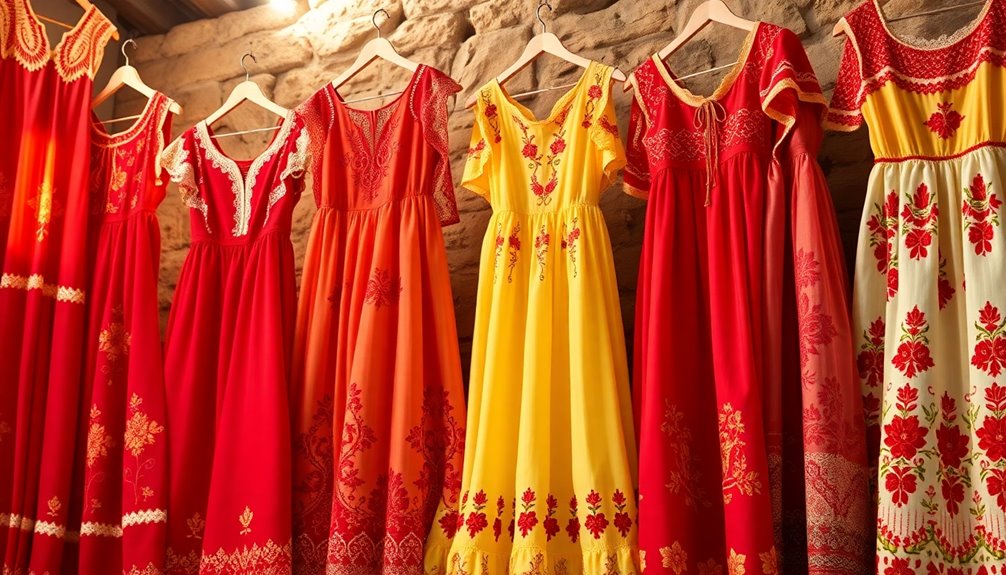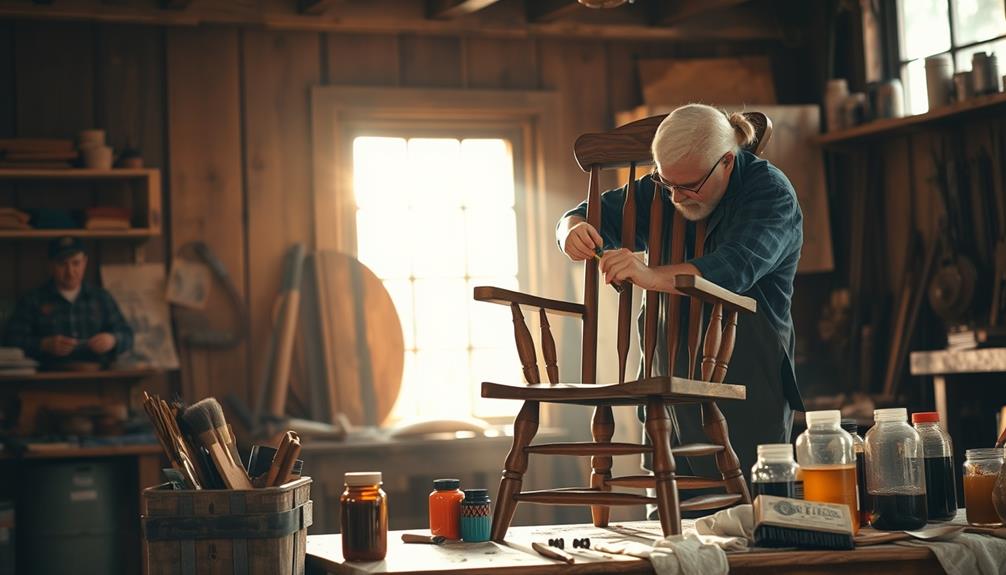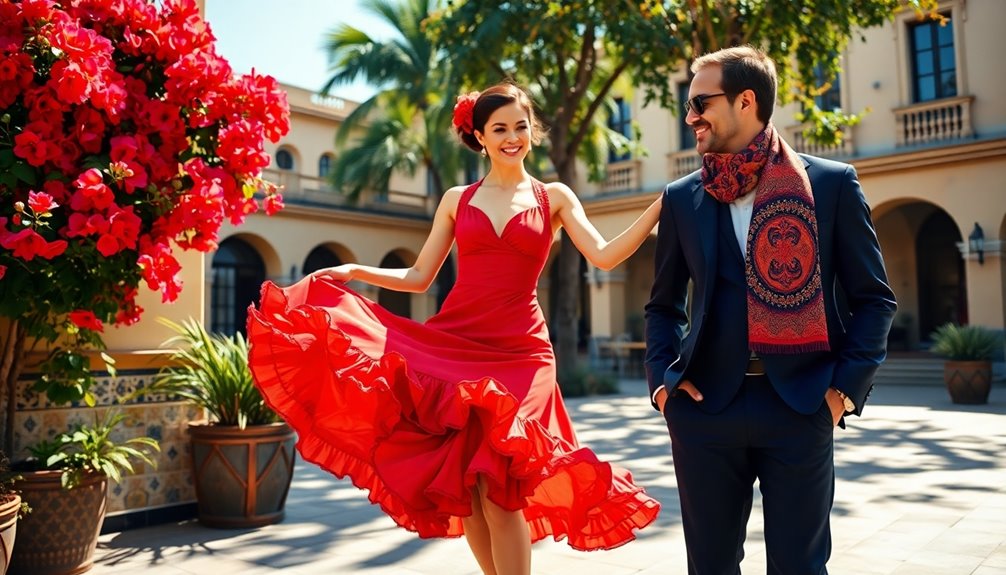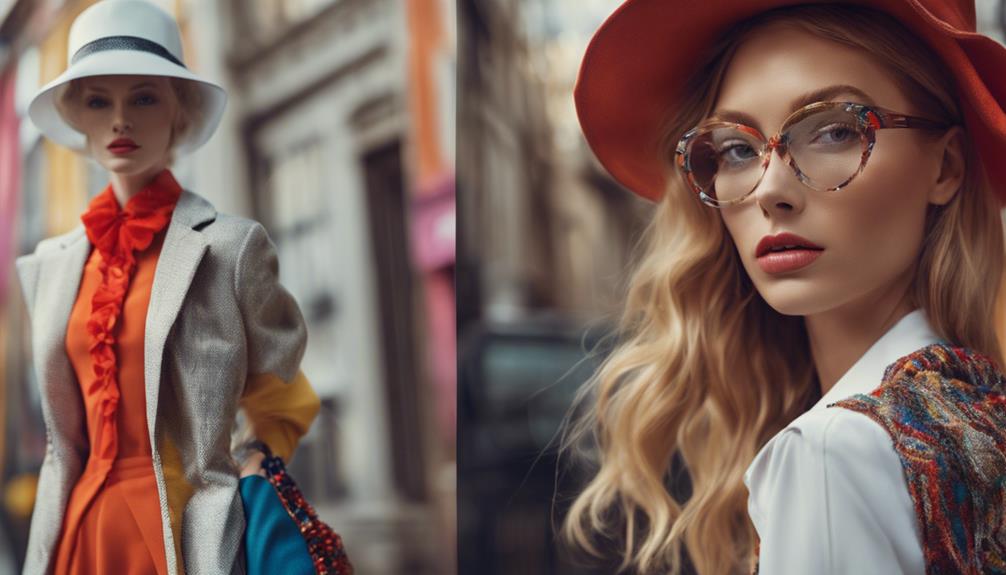When you explore Spanish dresses, you'll discover a rich tapestry of artisan fabrics and exquisite embroidery. These garments reflect centuries of craftsmanship, showcasing vibrant colors and intricate designs influenced by cultural heritage. From bohemian maxi dresses to flamenco-inspired styles, you'll find unique pieces that blend traditional techniques with modern sustainability. Each dress tells a story, thanks to hand-stitched detailing and creative patterns. Pairing these dresses with bold accessories enhances their beauty, making them perfect for any occasion. If you're interested in the various styles and shopping tips, there's a lot more to uncover about this captivating fashion trend.
Key Takeaways
- Spanish dresses feature vibrant artisan fabrics like linen, silk, and cotton, showcasing unique textures and colors that reflect regional identities.
- Intricate hand-stitched embroidery techniques, such as Blackwork, highlight cultural heritage and craftsmanship in modern Spanish fashion.
- Sustainable practices are emphasized in contemporary designs, often integrating eco-friendly materials and traditional artisan techniques.
- Signature styles include bohemian maxi dresses and off-shoulder designs, enhancing comfort while maintaining artistic flair through detailed patterns.
- Accessories like statement earrings and bold necklaces complement embroidered dresses, allowing for versatile styling without overpowering the intricate designs.
Origin and historical background of the fashion trend/style
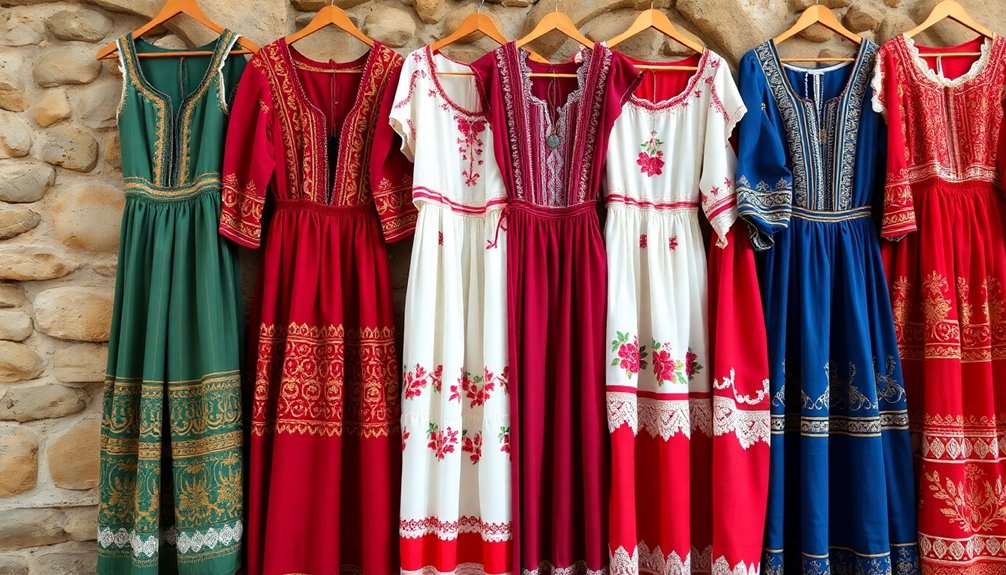
When you explore Spanish dresses, you'll notice a fascinating blend of historical textile craftsmanship and artisan techniques that have evolved over centuries.
From the vibrant colors influenced by Moorish designs to the intricate embroidery that tells stories of the past, these garments reflect a rich heritage.
Understanding this transformation helps you appreciate how traditional skills remain relevant in today's fashion landscape.
Historical Textile Craftsmanship Transformation
Spanish textile craftsmanship has undergone a remarkable transformation, rooted in a rich historical background that dates back to the early Middle Ages. Techniques like weaving and embroidery evolved over centuries, becoming integral to Spanish culture.
Traditional fabrics such as linen, silk, and wool showcased vibrant colors and intricate patterns, reflecting regional identities and social class distinctions. The influence of Moorish culture introduced elaborate designs that significantly shaped Spain's textile arts, paving the way for unique styles like Camariñas lace.
By the 18th and 19th centuries, the linen industry flourished, especially in Galicia, where many women contributed to the sector, highlighting gender dynamics within the craft.
Today, you can see the fruits of this historical transformation in modern Spanish textiles. Contemporary designs blend traditional craftsmanship with innovation, making artisan fabrics a vital part of fashion. This evolution in craftsmanship parallels the growing emphasis on sustainability within the fashion industry, as artisans seek to honor their heritage while addressing modern environmental challenges.
Global brands like Inditex have embraced this evolution, prioritizing sustainability while honoring their rich heritage. As you explore Spanish dresses, you're not just looking at fashion; you're witnessing centuries of artistry and cultural significance, all woven together through the lens of time.
Historical Artisan Techniques
The roots of artisan techniques in Spain's fashion scene run deep, tracing back to the early Middle Ages. During this period, intricate weaving and embroidery flourished among the nobility, showcasing their wealth and refinement.
Spanish textiles became renowned for their vibrant colors and patterns, heavily influenced by Moorish culture, with each region offering unique variations that reflected local customs and available resources.
Historical techniques like Blackwork embroidery have been meticulously passed down through generations, emphasizing the craftsmanship that defines Spain's rich textile heritage.
These artisan techniques aren't just skills; they carry cultural significance, offering a glimpse into the identity and traditions of the Spanish people. Fabrics made from linen, silk, and cotton continue to embody this heritage, often celebrated in various Spanish festivals and events.
In the late 20th century, the revival of traditional artisan practices sparked a renewed appreciation for these techniques, led by brands like Inditex.
This movement not only preserves the artistry of the past but also adapts it for modern consumers who seek authenticity in traditional fashion. Embracing these artisan techniques connects you to a vibrant history woven into every stitch.
Key Characteristics
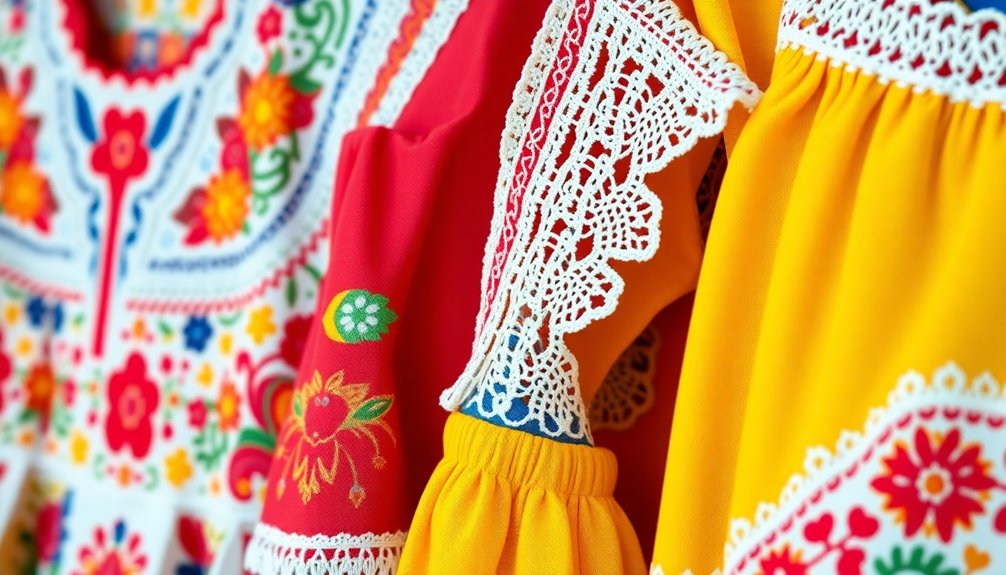
When exploring Spanish dresses, you'll notice their intricate hand-stitched embroidery patterns that tell a story of tradition and artistry.
These vibrant cotton and silk blends not only catch the eye but also offer a comfortable fit for any occasion.
The signature embroidered dress styles reflect a unique blend of cultural heritage and modern trends that you'll surely appreciate.
Intricate Hand-Stitched Embroidery Patterns
Many people admire the intricate hand-stitched embroidery patterns found in dresses from Spain, as they showcase a rich tapestry of cultural heritage. These patterns often feature floral motifs, geometric shapes, and regional symbols, each telling a story or conveying a message. When you wear one of these unique pieces, you connect to the traditions and history of the region.
Artisans employ traditional techniques like satin stitch, chain stitch, and cross-stitch, enhancing the texture and visual complexity of the embroidery patterns. The vibrant color palettes used in these designs not only add aesthetic appeal but also symbolize local customs, making every garment a reflection of its creator's identity and values.
Many of these intricate hand-stitched patterns are crafted from sustainable materials such as cotton and linen, ensuring durability while promoting eco-friendly practices in fashion. This commitment to sustainability means you can feel good about your purchase, knowing it supports both artisans and the environment.
In choosing these dresses, you embrace the artistry and cultural significance behind each stitch, wearing a piece of history that celebrates the vibrant spirit of Spain.
Vibrant Cotton and Silk Blends
Spanish dresses often feature vibrant cotton and silk blends that elevate both comfort and style. These fabrics are celebrated for their vibrant colors and intricate patterns, reflecting the cultural significance of Spain's regional traditions.
The combination of cotton and silk offers durability and breathability, making these dresses perfect for a variety of occasions, from casual outings to formal events. The elegant drape of silk enhances the overall aesthetic, while the cotton ensures ease of care and longevity.
You'll appreciate how these blends allow for movement without sacrificing style. Artisan techniques, such as hand embroidery and smocking, are often incorporated, showcasing traditional craftsmanship that breathes life into each piece.
These vibrant blends not only highlight Spain's rich textile heritage but also blend contemporary design elements with time-honored methods. When you wear a dress made from these cotton and silk blends, you're not just donning a beautiful garment; you're embracing a legacy steeped in artistry and cultural pride.
Whether it's the soft touch or the stunning visual appeal, these dresses truly embody the spirit of Spanish fashion.
Signature Embroidered Dress Styles
Embodying the essence of Spain's rich cultural heritage, signature embroidered dress styles stand out with their intricate detailing and vibrant designs. You'll find that these dresses often feature floral motifs, showcasing the artistry of skilled artisans.
Whether you're drawn to an embroidered maxi dress or a hand-embroidered vintage style, each piece tells its own story through the craftsmanship. The use of breathable fabrics like cotton and linen not only ensures comfort but also enhances the flowing silhouettes that many of these dresses possess.
These materials make them perfect for a variety of occasions, from casual gatherings to formal events. You might even consider a traditional Mexican dress for a unique flair that celebrates cultural intersections.
For those seeking something truly special, custom-made bridal dresses are a popular choice, highlighting luxurious fabrics and complex embroidery. The uniqueness of each embroidered dress, thanks to its handcrafted nature, ensures that no two pieces are identical, allowing you to support the artisan community behind these exquisite creations.
When you wear one of these dresses, you're not just donning clothing; you're embracing a vibrant piece of cultural heritage.
Modern Interpretation
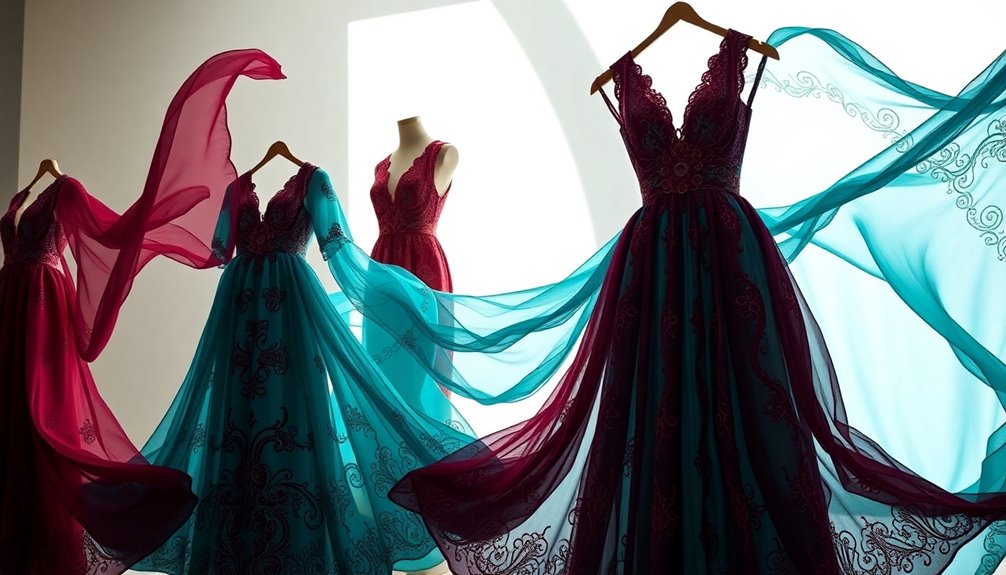
In today's fashion scene, you're seeing how renowned Spanish fashion houses are leading the charge in sustainable fabric innovations.
They're not just preserving traditional techniques; they're also redefining them to create modern pieces that appeal to a global audience.
Plus, the influence of fashion icons from Spain adds a unique flair, showcasing the perfect blend of heritage and contemporary style.
Sustainable Fabric Innovations
Sustainable fabric innovations are transforming the fashion landscape in Spain, where eco-friendly materials like organic cotton and recycled fibers are becoming the norm.
You'll find that Spanish textile manufacturers are increasingly adopting low-impact dyeing processes and water-efficient techniques, drastically minimizing water usage and chemical pollution in fabric production.
The revival of traditional weaving methods, paired with modern sustainable practices, not only preserves cultural heritage but also promotes ethical labor practices among artisans.
This commitment to artisan craftsmanship ensures that each piece reflects the skill and dedication of its maker.
Many brands embrace circular fashion principles, designing garments that can be easily repaired, reused, or recycled, extending the lifecycle of textiles.
By prioritizing these sustainable fabrics, you're supporting a movement that values quality and durability while reducing environmental impact.
Collaborations between designers and local artisans further emphasize the use of sustainably sourced materials, creating unique pieces that honor Spanish textile traditions.
As you explore these innovations, you'll appreciate how they blend heritage and modernity, showcasing a future where fashion isn't just beautiful but also responsible.
Renowned Spanish Fashion Houses
Spain's fashion scene is a vibrant tapestry woven from rich traditions and contemporary flair, showcasing the work of renowned fashion houses that expertly merge craftsmanship with modern design. Brands like Zara and Massimo Dutti blend traditional craftsmanship with sleek aesthetics, making Spanish fashion a global phenomenon.
Balenciaga, founded by Cristóbal Balenciaga in 1919, revolutionized haute couture with innovative designs that continue to inspire. Likewise, Loewe, established in 1846, emphasizes artisanal techniques in its luxury leather goods, ensuring quality alongside contemporary collections.
Desigual stands out with its vibrant, eclectic designs that embrace artisan textiles and bold embroidery, reflecting Spain's cultural diversity. This commitment to artistic expression enriches the fashion landscape, showcasing the country's unique heritage.
As sustainable fashion rises in importance, Spanish fashion houses are responding by integrating eco-friendly materials and production methods. Brands like Ecoalf highlight this shift, promoting a resurgence of interest in artisanal practices while honoring traditional Spanish textile heritage.
Together, these renowned Spanish fashion houses not only celebrate craftsmanship but also pave the way for a more sustainable future in the industry.
Fashion Icons of Spain
The world of fashion is undeniably influenced by a host of dynamic Spanish icons who've redefined style through innovative design. Designers like Cristóbal Balenciaga and Paco Rabanne laid the groundwork with their unique blend of traditional Spanish garments and modern aesthetics, creating a lasting impact.
Today, contemporary designers such as Alejandro Gómez Palomo and Teresa Helbig continue this legacy, showcasing exquisite craftsmanship and using artisan fabrics that reflect Spain's rich textile heritage.
Modern Spanish brands like Zara and Mango exemplify the seamless integration of traditional embroidery techniques into ready-to-wear collections, making these designs accessible to a global audience.
Spanish fashion weeks, especially in Madrid, spotlight emerging talents who reinterpret classic styles while emphasizing sustainable practices, proving that fashion can be eco-conscious.
The flamenco dress, a symbol of Spain's cultural richness, remains an enduring source of inspiration.
Today's designers create contemporary pieces that honor this tradition, ensuring cultural significance while appealing to fashion-forward consumers.
These fashion icons and their innovative approaches highlight Spain's unique position in the global fashion landscape, merging history with modernity in a captivating way.
Styling Tips
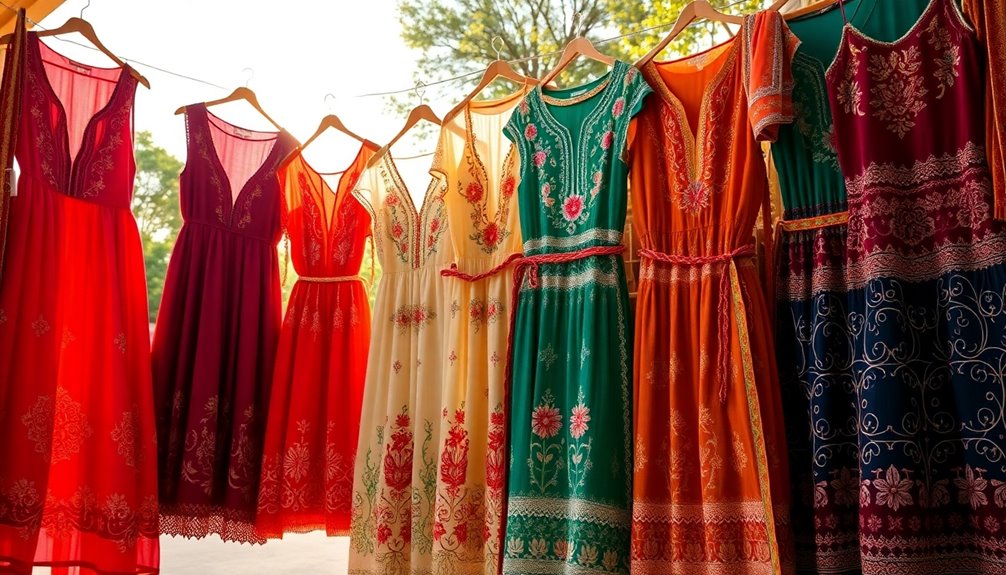
When styling your Spanish embroidered dress, think about incorporating colorful accessories that highlight the intricate details of the fabric.
Layering with contrasting textures can add depth to your outfit while keeping it fresh and stylish.
Essential Embroidered Dress Styles
Embroidered dresses are a vibrant addition to any wardrobe, offering a blend of style and cultural richness. When you think of essential embroidered styles, bohemian maxi dresses immediately come to mind. These flowing silhouettes, adorned with intricate designs, are perfect for both casual outings and formal events.
Opt for dresses made from traditional artisan fabrics like cotton or linen, as they enhance comfort and breathability—ideal for warm climates and summer wear. Look for hand-stitched details and floral motifs that not only reflect cultural heritage but also showcase artisanal craftsmanship.
Versatility is key, so consider off-shoulder or smocked designs that provide flexibility in fit and style, making them suitable for various body types and occasions.
When styling your embroidered dress, keep accessories simple to allow the intricate embroidery to shine. A delicate pair of earrings or a minimalist bracelet can enhance your look without overwhelming it.
Colorful Accessories for Embroidery Dresses
Accessorizing an embroidered dress can elevate your look and showcase the intricate details of the fabric. To make your outfit pop, consider colorful accessories that enhance the design without overwhelming it. Statement earrings or bold necklaces in bright hues can draw attention to the embroidery, adding a vibrant touch.
A contrasting handbag in a lively color is another way to highlight the embroidered patterns. It should complement the dress rather than compete with it.
For a stylish silhouette, incorporate woven or beaded belts to cinch the waist of loose-fitting embroidered dresses. This not only adds structure but also infuses that charming bohemian vibe.
When it comes to footwear, choose sandals or espadrilles that align with the color palette of your dress. This creates a cohesive look, allowing the embroidery to remain the focal point.
Lastly, consider layering with a colorful shawl or lightweight scarf. This accessory not only provides warmth and texture but also enhances the artistic flair of your embroidered dress, making your ensemble truly unique. Additionally, think about the dress code on a cruise as it may influence your choice of accessories.
With these tips, you'll effortlessly elevate your style while celebrating the beauty of your embroidered pieces.
Layering With Contrasting Textures
Combining contrasting textures can elevate your look while adding depth and interest to your outfit. Layering is key, so consider pairing a lightweight embroidered blouse with a heavier linen skirt. This not only adds dimension but maintains balance, allowing the intricate craftsmanship of the blouse to shine.
You might also try wearing a vintage black hand-embroidered vest over a simple dress; it enhances the overall aesthetic and showcases artisanal skills.
Mixing smooth fabrics with textured pieces can create a stylish contrast perfect for transitional weather. For example, a sleek satin dress paired with a chunky knit cardigan offers both warmth and style.
Don't forget about accessorizing; leather boots with a flowy bohemian dress can add an edgy twist while reflecting a modern take on traditional designs.
Ultimately, layering with contrasting textures isn't just about looking good—it's about expressing your unique style. Whether you're incorporating artisan fabrics or emphasizing the beauty of embroidered pieces, these tips will help you create a visually captivating outfit that's rich in character and charm.
Shopping Guide
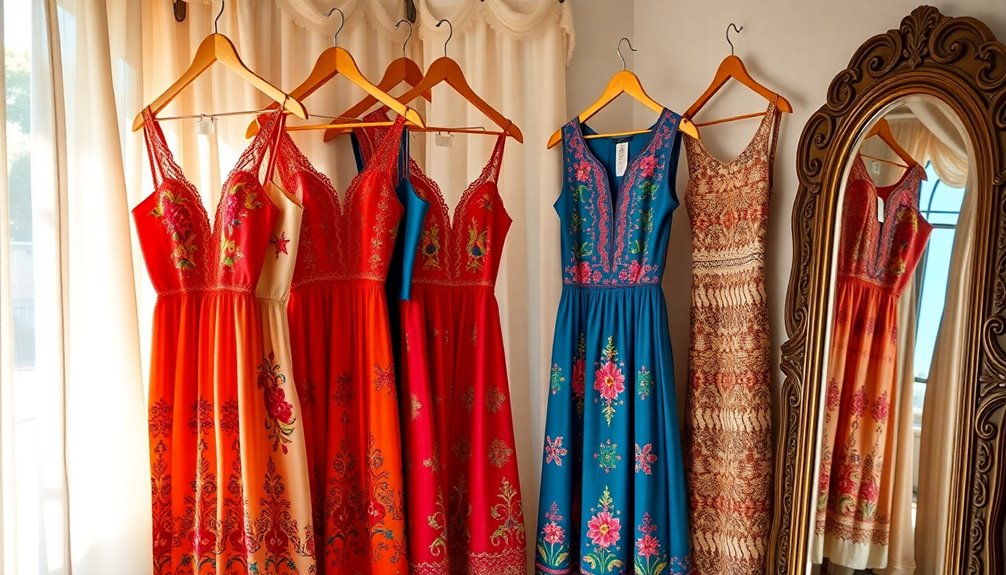
When you’re on the hunt for dresses from Spain, you’ll often find that the selection showcases unique artisan fabrics like linen, silk, and cotton. These materials aren’t only comfortable but also feature vibrant colors and intricate patterns that reflect centuries of traditional craftsmanship. Moreover, many of these dresses are designed with a contemporary twist, making them suitable for both casual outings and special occasions. If you’re looking to embrace your individuality, artisan clothing from Spain offers an array of styles that truly stand out. From flowing maxi dresses to tailored ensembles, you’ll discover pieces that not only celebrate heritage but also allow for personal expression.
As you browse, pay attention to the detailed embroidery techniques, including Blackwork and local styles, which add aesthetic appeal and cultural significance to each piece.
Sizes typically range from S to plus sizes, making it easier for you to find a fit that suits your body type while embracing inclusivity in design. Prices for these artisan dresses can vary significantly, usually starting around £40 and going up to £140.
Keep an eye out for discounts available, sometimes reaching up to 60% off on select items.
To enhance your shopping experience, utilize sorting options on e-commerce platforms. This way, you can filter dresses by best-selling items, price, or new arrivals, ensuring a user-friendly shopping experience tailored to your preferences.
With these tips in mind, you'll be well-equipped to find the perfect dress that embodies the beauty of Spanish craftsmanship.
Sewing Techniques for Personalization
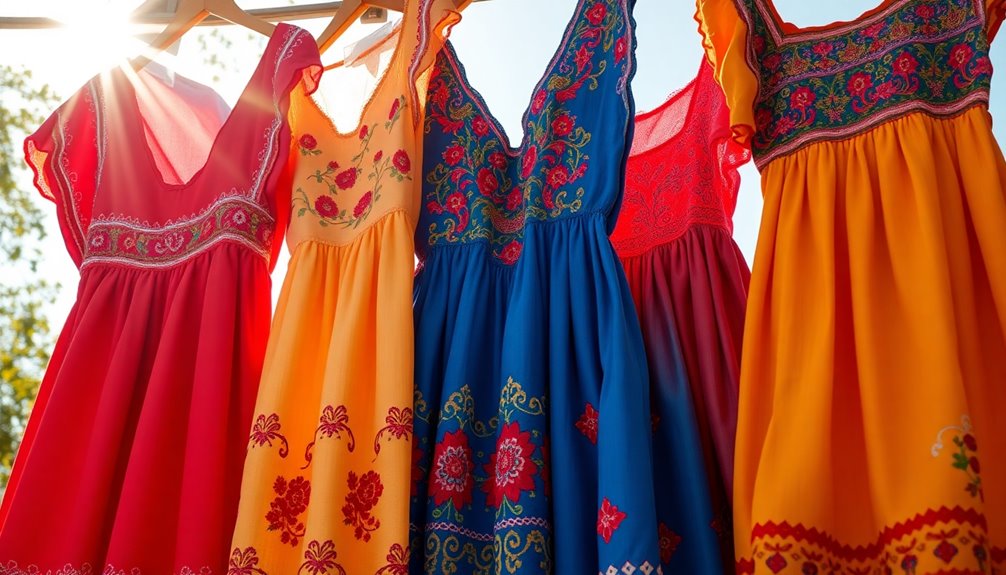
When you want to personalize your dress, embroidery techniques can take it to the next level.
By adding unique embroidery motifs, you can infuse your garment with your style and heritage.
Experimenting with different stitches and patterns not only enhances the dress's look but also makes it a true reflection of you.
Embroidery Techniques for Personalization
Embroidery techniques like cross-stitch and satin stitch not only allow you to create intricate designs but also let you infuse your personal style into garments. By using these techniques, you can reflect cultural motifs that resonate with you, enhancing the overall personalization of your dress.
Hand embroidery offers a unique touch, as each stitch is crafted with care, making your piece truly one-of-a-kind.
To boost the visual appeal of your creation, consider using contrasting threads. This approach makes personalized elements pop against the artisan fabrics you choose. Additionally, incorporating appliqué techniques involves sewing pieces of fabric onto the base, adding dimension and texture to your embroidered designs.
Exploring traditional Spanish embroidery styles, such as Blackwork or Reticella, can also elevate your garments. These techniques not only celebrate heritage but also create a unique fashion statement that stands out.
Add Unique Embroidery Motifs
Adding unique embroidery motifs to your dress can truly elevate its charm and personality. By using techniques like satin stitch, chain stitch, and cross-stitch, you can express your individuality while customizing your garment.
Consider incorporating traditional Spanish motifs, such as floral designs or geometric patterns, to enhance the cultural significance of your embroidery.
When choosing your thread, opt for contrasting colors to make your embroidery stand out. This approach adds visual interest and depth to the overall design, transforming your dress into a true work of art.
Remember, hand embroidery often involves intricate details that require a steady hand and patience, making each piece genuinely unique and artisan in nature.
Customizing dresses with personalized embroidery not only showcases your style but also preserves the traditional craftsmanship techniques passed down through generations. Additionally, the meticulous nature of hand embroidery reflects the values of mindfulness, respect, and harmony found in cultural practices such as the traditional tea ceremony.
Whether you're adding delicate florals or bold geometric shapes, your unique embroidery will tell a story that resonates with Spanish heritage.
Cultural Impact
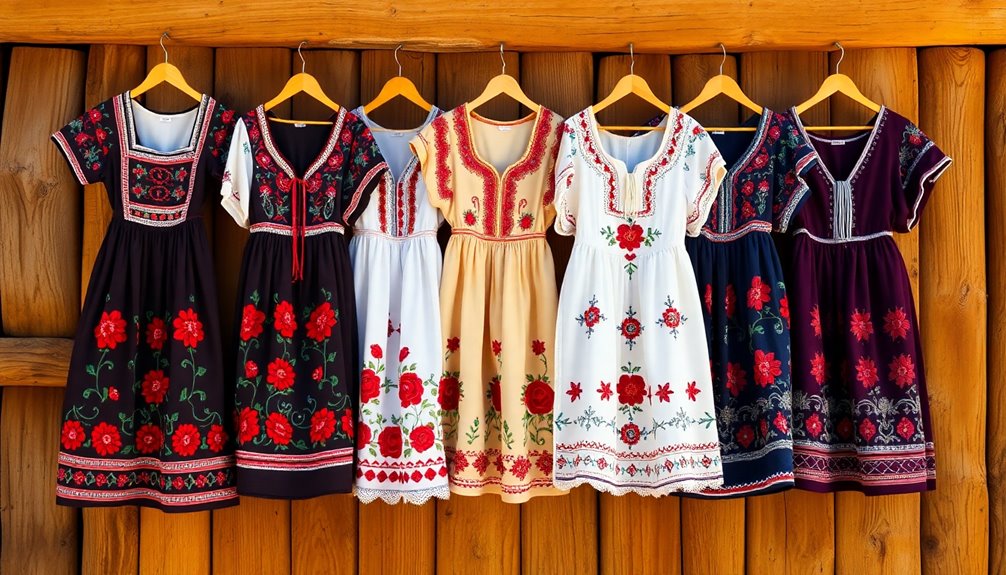
When you look at flamenco-inspired fashion trends, you can see how they reflect a deep cultural pride and identity.
These styles not only celebrate traditional Spanish heritage but also fuel conversations around fashion activism and the importance of representation.
Flamenco-Inspired Fashion Trends
Flamenco-inspired fashion trends are captivating fashion enthusiasts around the globe, evoking the spirit of Andalusian culture. These trends often showcase vibrant colors, ruffles, and polka dots, reflecting the dynamic and expressive nature of flamenco dance. The traditional flamenco dress, or traje de flamenca, features a fitted bodice, flared sleeves, and a voluminous skirt designed to enhance movement, allowing wearers to embody the grace of the dance.
Designers are increasingly incorporating flamenco elements into contemporary collections, blending traditional aesthetics with modern silhouettes. This fusion not only appeals to a broader audience but also preserves the cultural heritage of Spain.
Celebrations like the Feria de Abril in Seville highlight the significance of flamenco dresses, where women dress in elaborate outfits adorned with intricate embroidery, showcasing both regional pride and identity.
The global rise in popularity of flamenco has led to a surge in artisan-produced garments made from traditional Spanish textiles. These pieces promote sustainable fashion practices while honoring the craftsmanship of skilled artisans.
As you explore these trends, you'll discover a vibrant connection to the rich cultural tapestry of Spain, celebrating both its history and its future.
Fashion Activism and Identity
Fashion activism in Spain is reshaping how cultural identity is expressed through clothing. Designers and artisans are embracing traditional techniques like hand embroidery and smocking to preserve their rich heritage. By prioritizing artisan fabrics and sustainable practices, they create garments that tell stories while fostering a deeper connection to Spanish culture. This movement encourages you to support local artisans, ensuring that the history of Spanish textiles thrives.
You'll notice that many Spanish fashion designers weave cultural motifs into their contemporary fashion collections. This fusion allows for dialogue between the past and present, reinforcing national identity through modern interpretations. Events like Madrid Fashion Week highlight this commitment, showcasing how traditional designs can be reimagined for global audiences.
Moreover, the promotion of handmade garments serves as a form of cultural activism. It challenges the fast fashion norms that often overlook quality and heritage.
Frequently Asked Questions
What Types of Fabrics Are Typically Used in Spanish Dresses?
When you're exploring Spanish dresses, you'll find a variety of fabrics that bring them to life.
Common choices include lightweight cotton for comfort, vibrant silk for elegance, and rich brocade for structure.
You might also encounter linen, perfect for warm climates, and lace, adding a delicate touch.
Each fabric plays a role in the dress's overall design, reflecting Spain's rich textile tradition and cultural heritage.
How Can I Maintain the Quality of Embroidered Dresses?
To maintain the quality of your embroidered dresses, start by hand-washing them in cold water with a gentle detergent.
Avoid wringing them out; instead, lay them flat to dry. Keep them away from direct sunlight to prevent fading.
When storing, use breathable garment bags and avoid hangers that could stretch the fabric.
Regularly check for loose threads and repair them promptly to keep the embroidery looking fresh and vibrant.
Are There Specific Occasions for Wearing Artisan Dresses?
Absolutely, there are specific occasions where artisan dresses shine.
You can wear them for weddings, garden parties, or cultural festivals, showcasing their unique craftsmanship. They're perfect for family gatherings or brunches, adding a touch of elegance.
Even casual outings can benefit from an artisan dress, making you stand out effortlessly.
Just remember, the key is to match the dress's style with the event's formality for a polished look that turns heads.
What Is the Price Range for Handmade Spanish Dresses?
When you're looking for handmade Spanish dresses, you'll find the price range varies quite a bit.
Generally, you can expect to pay anywhere from $100 to $1,000, depending on the intricacy of the design and the materials used.
For simpler styles, you might spend less, while more elaborate pieces with detailed embroidery could be at the higher end.
It's best to explore different artisans to find something that fits your style and budget.
Where Can I Find Authentic Spanish Dressmakers?
To find authentic Spanish dressmakers, start by exploring local artisan markets or craft fairs in your area.
You can also search online platforms like Etsy, where many talented dressmakers showcase their work.
Social media, especially Instagram, is another great resource; follow hashtags related to Spanish fashion to discover creators.
Don't forget to ask for recommendations from friends or fashion enthusiasts who appreciate handmade clothing.
You'll soon connect with skilled artisans!
